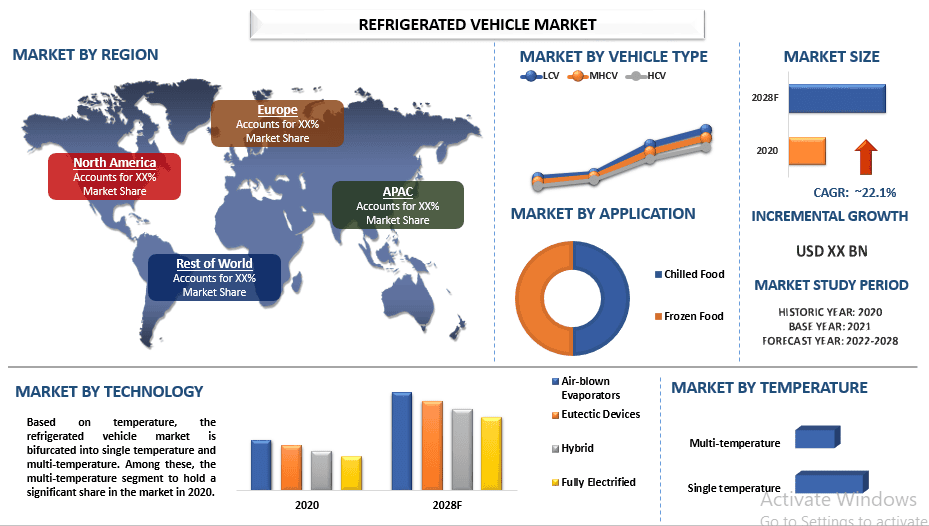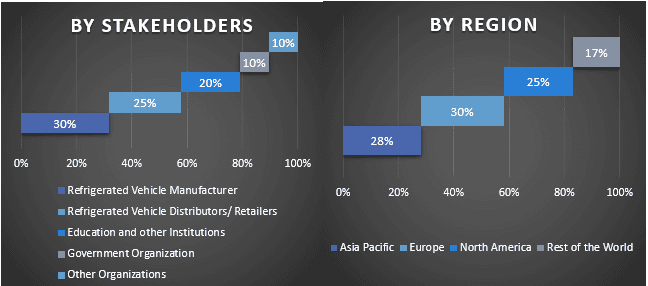Refrigerated Vehicle Market: Current Analysis and Forecast (2022-2028)
Emphasis on Vehicle Type (LCV, MHCV, HCV); Application (Chilled Food, Frozen Food); Temperature (Single temperature, Multi-temperature); Technology (Air-blown Evaporators, Eutectic Devices, Hybrid, Fully Electrified); and Region/Country

The global Refrigerated Vehicle Market is expected to grow at a significant rate of around 6.3% during the forecast period. refrigerated vehicle manufacturers are working on designing technologies to minimize their environmental impacts, such as carbon footprint and noise pollution are the key factors driving the market. In addition, rising global warming has a major impact on the food producers globally which is reducing the shelf life of these products in non-refrigerated conditions. Most pharmaceutical and healthcare products need protection from heat and light to maintain their chemical and biological formulation escalating the adoption of refrigerated vehicles.
United Technologies Corporation, DAIKIN INDUSTRIES Ltd., Ingersoll Rand, Utility Trailer Manufacturing Company, Tata Motors, Nabors Industries Ltd., Hyundai, Singamas Container Holdings Limited, LAMBERET SAS, KRONE.
Insights Presented in the Report
“Amongst vehicle types, MHCV category to witness robust CAGR during the forecast period”
Based on vehicle type, the refrigerated vehicle market is segmented into the LCV, MHCV, and HCV. Open hole category to witness higher CAGR during the forecast period. Among vehicle types, MHCV caters to an extensive share of the refrigerated vehicle market. Refrigerated MHCVs are used for medium-distance transportation from one city to another to deliver perishable goods such as fish, meat, milk, and dairy products. The increase in the use of multi-temperature refrigerated systems provides an option to transport more than one perishable item at a time, improving transportation efficiency via trucks.
“Amongst application, chilled food segment to hold a significant share in the market in 2020”
Based on application, the refrigerated vehicle market is classified into chilled food and frozen food. Among these, the chilled food segment to hold a significant share in the market in 2020. The growing consumption of convenience food in emerging economies is escalating its market share. In addition, the expansion of fast-food chains and supermarkets is expected to create lucrative opportunities for chilled food product manufacturers and refrigerated transport service providers in the coming years.
“Amongst temperature, multi-temperature segment to hold a significant share in the market in 2020”
Based on temperature, the refrigerated vehicle market is bifurcated into single temperature and multi-temperature. Among these, the multi-temperature segment to hold a significant share in the market in 2020. The rising growth of the food service industry required a fleet of multi-temperature refrigerator trailers that are equipped with evaporators and host unit controls that provide different temperatures in one trailer.
“Amongst technology, fully electrified segment to hold a significant share in the market in 2020”
Based on technology, the refrigerated vehicle market is segmented into air-blown evaporators, eutectic devices, hybrid, and fully electrified. Among these, the fully electrified segment to hold a significant share in the market in 2020. It is mainly owing to its potentially lower operating costs, zero tailpipe emissions, significantly quieter drive at low speeds, and provide higher energy efficiency.
“Europe to hold a significant share in the market”
Europe is anticipated to grow at a substantial CAGR during the forecast period. This is mainly due to due to the development of network-focused technological solutions, technological up-gradation in refrigerated systems & transport, and the focus on the implementation of quality standards set by the public and private sector.
Reasons to buy this report:
- The study includes market sizing and forecasting analysis validated by authenticated key industry experts.
- The report presents a quick review of overall industry performance at one glance.
- The report covers an in-depth analysis of prominent industry peers with a primary focus on key business financials, product portfolio, expansion strategies, and recent developments.
- Detailed examination of drivers, restraints, key trends, and opportunities prevailing in the industry.
- The study comprehensively covers the market across different segments.
- Deep dive regional level analysis of the industry.
Customization Options:
The global refrigerated vehicle market can further be customized as per the requirement or any other market segment. Besides this, UMI understands that you may have your own business needs, hence feel free to connect with us to get a report that completely suits your requirements.
Table of Contents
Research Methodology for the Refrigerated Vehicle Market Analysis (2022-2028)
Analyzing the historical market, estimating the current market, and forecasting the future market of the global refrigerated vehicle market were the three major steps undertaken to create and analyze the adoption of refrigerated vehicles in major regions globally. Exhaustive secondary research was conducted to collect the historical market numbers and estimate the current market size. Secondly, to validate these insights, numerous findings and assumptions were taken into consideration. Moreover, exhaustive primary interviews were also conducted, with industry experts across the value chain of the global refrigerated vehicle market. Post assumption and validation of market numbers through primary interviews, we employed a top-down/bottom-up approach to forecasting the complete market size. Thereafter, market breakdown and data triangulation methods were adopted to estimate and analyze the market size of segments and sub-segments of the industry pertains to. Detailed methodology is explained below:
Analysis of Historical Market Size
Step 1: In-Depth Study of Secondary Sources:
Detail secondary study was conducted to obtain the historical market size of the refrigerated vehicle market through company internal sources such as annual reports & financial statements, performance presentations, press releases, etc., and external sources including journals, news & articles, government publications, competitor publications, sector reports, third-party database, and other credible publications.
Step 2: Market Segmentation:
After obtaining the historical market size of the refrigerated vehicle market, we conducted a detailed secondary analysis to gather historical market insights and share for different segments & sub-segments for major regions. Major segments are included in the report as vehicle type, application, temperature, and technology. Further country-level analyses were conducted to evaluate the overall adoption of testing models in that region.
Step 3: Factor Analysis:
After acquiring the historical market size of different segments and sub-segments, we conducted a detailed factor analysis to estimate the current market size of the refrigerated vehicle market. Further, we conducted factor analysis using dependent and independent variables such as various vehicle types, applications, temperature, and technology. A thorough analysis was conducted for demand and supply-side scenarios considering top partnerships, mergers and acquisitions, business expansion, and product launches in the Refrigerated Vehicle market sector across the globe.
Current Market Size Estimate & Forecast
Current Market Sizing: Based on actionable insights from the above 3 steps, we arrived at the current market size, key players in the global refrigerated vehicle market, and market shares of the segments. All the required percentage shares split, and market breakdowns were determined using the above-mentioned secondary approach and were verified through primary interviews.
Estimation & Forecasting: For market estimation and forecast, weights were assigned to different factors including drivers & trends, restraints, and opportunities available for the stakeholders. After analyzing these factors, relevant forecasting techniques i.e., the top-down/bottom-up approach were applied to arrive at the market forecast for 2027 for different segments and sub-segments across the major markets globally. The research methodology adopted to estimate the market size encompasses:
- The industry’s market size, in terms of revenue (USD) and the adoption rate of the Refrigerated Vehicle market across the major markets domestically
- All percentage shares, splits, and breakdowns of market segments and sub-segments
- Key players in the global Refrigerated Vehicle market in terms of service offered. Also, the growth strategies adopted by these players to compete in the fast-growing market
Market Size and Share Validation
Primary Research: In-depth interviews were conducted with the Key Opinion Leaders (KOLs) including Top Level Executives (CXO/VPs, Sales Head, Marketing Head, Operational Head, Regional Head, Country Head, etc.) across major regions. Primary research findings were then summarized, and statistical analysis was performed to prove the stated hypothesis. Inputs from primary research were consolidated with secondary findings, hence turning information into actionable insights.
Split of Primary Participants in Different Regions

Market Engineering
The data triangulation technique was employed to complete the overall market estimation and to arrive at precise statistical numbers for each segment and sub-segment of the global refrigerated vehicle market. Data was split into several segments & sub-segments post studying various parameters and trends in the areas of vehicle type, application, temperature, and technology in the global refrigerated vehicle market.
The main objective of the Global Refrigerated Vehicle Market Study
The current & future market trends of the global refrigerated vehicle market were pinpointed in the study. Investors can gain strategic insights to base their discretion for investments on the qualitative and quantitative analysis performed in the study. Current and future market trends determined the overall attractiveness of the market at a regional level, providing a platform for the industrial participant to exploit the untapped market to benefit from a first-mover advantage. Other quantitative goals of the studies include:
- Analyze the current and forecast market size of the refrigerated vehicle market in terms of value (USD). Also, analyze the current and forecast market size of different segments and sub-segments
- Segments in the study include areas of vehicle type, application, temperature, and technology.
- Define and analysis of the regulatory framework for the refrigerated vehicle
- Analyze the value chain involved with the presence of various intermediaries, along with analyzing customer and competitor behaviors of the industry.
- Analyze the current and forecast market size of the refrigerated vehicle market for the major region.
- Major countries of regions studied in the report include Asia Pacific, Europe, North America, and the Rest of the World.
- Company profiles of the refrigerated vehicle market and the growth strategies adopted by the market players to sustain in the fast-growing market
- Deep dive regional level analysis of the industry
Related Reports
Customers who bought this item also bought










